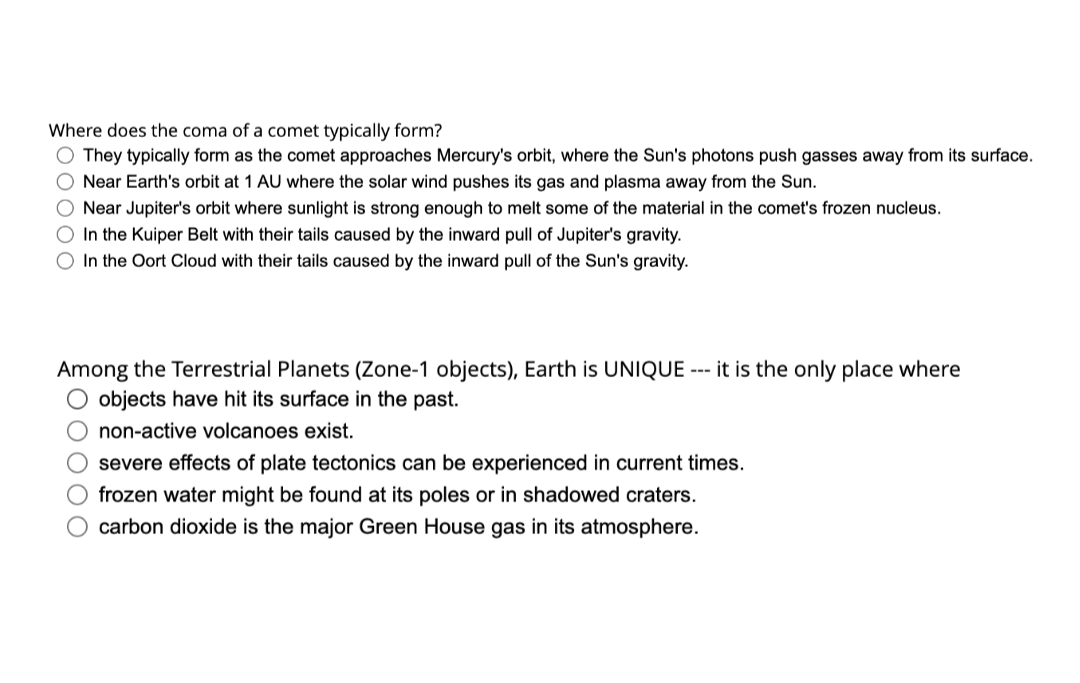Where does the coma of a comet typically form? They typically form as the comet approaches Mercury's orbit, where the Sun's photons push gasses away from its surface. Near Earth's orbit at 1 AU where the solar wind pushes its gas and plasma away from the Sun. O Near Jupiter's orbit where sunlight is strong enough to melt some of the material in the comet's frozen nucleus. O In the Kuiper Belt with their tails caused by the inward pull of Jupiter's gravity. In the Oort Cloud with their tails caused by the inward pull of the Sun's gravity.
Where does the coma of a comet typically form? They typically form as the comet approaches Mercury's orbit, where the Sun's photons push gasses away from its surface. Near Earth's orbit at 1 AU where the solar wind pushes its gas and plasma away from the Sun. O Near Jupiter's orbit where sunlight is strong enough to melt some of the material in the comet's frozen nucleus. O In the Kuiper Belt with their tails caused by the inward pull of Jupiter's gravity. In the Oort Cloud with their tails caused by the inward pull of the Sun's gravity.
Applications and Investigations in Earth Science (9th Edition)
9th Edition
ISBN:9780134746241
Author:Edward J. Tarbuck, Frederick K. Lutgens, Dennis G. Tasa
Publisher:Edward J. Tarbuck, Frederick K. Lutgens, Dennis G. Tasa
Chapter1: The Study Of Minerals
Section: Chapter Questions
Problem 1LR
Related questions
Question
Please answer both the questions,it's a request...and just give the explanation for the correct option..no need to explain all the options... thank you.

Transcribed Image Text:Where does the coma of a comet typically form?
O They typically form as the comet approaches Mercury's orbit, where the Sun's photons push gasses away from its surface.
Near Earth's orbit at 1 AU where the solar wind pushes its gas and plasma away from the Sun.
O Near Jupiter's orbit where sunlight is strong enough to melt some of the material in the comet's frozen nucleus.
O In the Kuiper Belt with their tails caused by the inward pull of Jupiter's gravity.
O In the Oort Cloud with their tails caused by the inward pull of the Sun's gravity.
Among the Terrestrial Planets (Zone-1 objects), Earth is UNIQUE --- it is the only place where
O objects have hit its surface in the past.
O non-active volcanoes exist.
O severe effects
plate
onics can be experienced
current times.
O frozen water might be found at its poles or in shadowed craters.
O carbon dioxide is the major Green House gas in its atmosphere.
Expert Solution
This question has been solved!
Explore an expertly crafted, step-by-step solution for a thorough understanding of key concepts.
Step by step
Solved in 3 steps

Recommended textbooks for you

Applications and Investigations in Earth Science …
Earth Science
ISBN:
9780134746241
Author:
Edward J. Tarbuck, Frederick K. Lutgens, Dennis G. Tasa
Publisher:
PEARSON

Exercises for Weather & Climate (9th Edition)
Earth Science
ISBN:
9780134041360
Author:
Greg Carbone
Publisher:
PEARSON

Environmental Science
Earth Science
ISBN:
9781260153125
Author:
William P Cunningham Prof., Mary Ann Cunningham Professor
Publisher:
McGraw-Hill Education

Applications and Investigations in Earth Science …
Earth Science
ISBN:
9780134746241
Author:
Edward J. Tarbuck, Frederick K. Lutgens, Dennis G. Tasa
Publisher:
PEARSON

Exercises for Weather & Climate (9th Edition)
Earth Science
ISBN:
9780134041360
Author:
Greg Carbone
Publisher:
PEARSON

Environmental Science
Earth Science
ISBN:
9781260153125
Author:
William P Cunningham Prof., Mary Ann Cunningham Professor
Publisher:
McGraw-Hill Education

Earth Science (15th Edition)
Earth Science
ISBN:
9780134543536
Author:
Edward J. Tarbuck, Frederick K. Lutgens, Dennis G. Tasa
Publisher:
PEARSON

Environmental Science (MindTap Course List)
Earth Science
ISBN:
9781337569613
Author:
G. Tyler Miller, Scott Spoolman
Publisher:
Cengage Learning

Physical Geology
Earth Science
ISBN:
9781259916823
Author:
Plummer, Charles C., CARLSON, Diane H., Hammersley, Lisa
Publisher:
Mcgraw-hill Education,